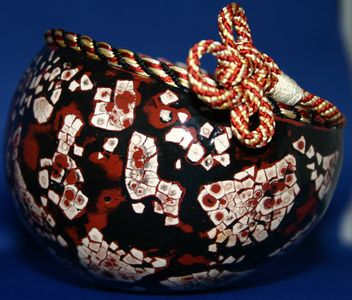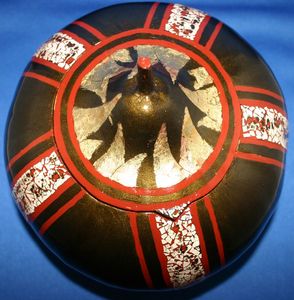Rankaku: eggshell inlay
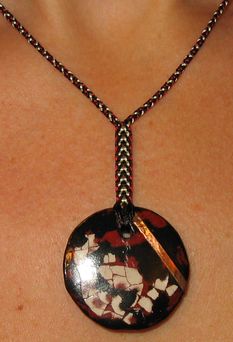 In January 08 Claire Cassan taught us her eggshell technique and we
practiced on a small pendant.
In January 08 Claire Cassan taught us her eggshell technique and we
practiced on a small pendant.The technique described below is a
simplified version of an ancient Japanese lacquer-ware technique, 'rankaku'
meaning eggshell in Japanese. The red on black pattern is called Negoro, it
is achieved by covering several layers of black lacquer by a few layers of
red lacquer. Careful sanding of the red layers reveals the black. Associated
to the white of the eggshell it gives a very intriguing effect.
Before starting this project, be aware that it is very time consuming. It
takes at least 3 hours for a small pendant, during that time you will paint
and sand and again. What I describe is already very simplified compared to
what a Japanese lacquer artisan would do.
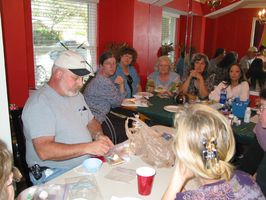

Supplies
- A small gourd piece, sanded
- Sand paper: 200, 300, 400, 600
- Sanding mask
- Liquitex gloss varnish flexible surface or JW's etc Right Step, (Hobby Lobby, painting
supplies). I chose these brands because they dry quickly
- Pigments: Gamblin brand 'ivory black' and 'indian red' (Dick Blick)
- Awl, toothpicks
- Paper towel
- eggshell
- small cups
- small synthetic flat brush (1/4'')
Preparation
- Sand the gourd piece
- Drill a hole for your pendant
- Remove the white skin inside the eggshell. It is easy to remove when the
eggshell is fresh, otherwise let it soak a few minutes in warm water.
Safety
- Wear your mask when using the pigments and when sanding
- Clean your hands thoroughly after sanding
Inlay
Note: The explanation below is for a 'black first, red last' succession of
layers. It may not match the pictures.
- Mix black pigment with the varnish. The consistency must be thick, like
pancake batter.
- Paint one layer of varnish on your entire gourd piece. If the varnish has
the right consistency the gourd should not show through
- Let dry.
- Apply black varnish to the area where the eggshell will be placed. Work
one small area at a time, or the varnish will try before you apply the shells.
- Break a piece of eggshell, to fit in your area, but no bigger than a
quarter.
- Place your eggshell on the wet area, inside facing you,
- Delicately break the shell with your fingers. An awl or toothpick will
help you place the pieces.
- It will look like a mosaic
- The pieces of shell must be broken until they lay flat on the gourd shell.
Any piece that sticks out will be sanded away
- If you didn't remove the white skin, the shell will not break properly
- If your varnish isn't wet the eggshell will not stick.
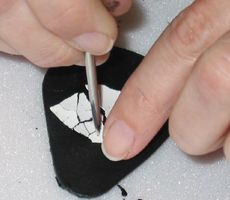
|

Note: I did my design red first, and black last. It is up to you. |
- Let it dry.
- Cover the entire gourd piece with black varnish. Paint several
layers, letting dry between each layer, until the shells are almost flush with
the surrounding as shown below.
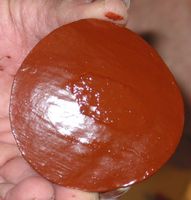
- You're ready to start sanding.
- Select a 200 or so grit and carefully sand the entire gourd, until you see
the eggshell and it is smooth to the touch.
- If the sanding removes too much eggshell. Apply more black varnish to cover all again, and sand.
- Do not sand the eggshell to the point where they are not concave anymore, e.g. try to keep a spot of black
in the middle of each eggshell piece. It will create a very nice effect at the end.
- Yes, it is messy, and rather ugly at that point. Have faith.
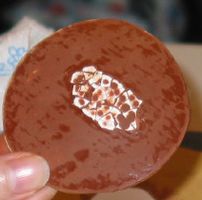

|
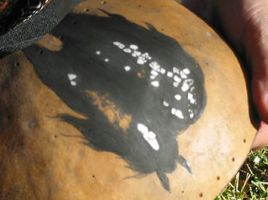
Horse design by Darla Hines:
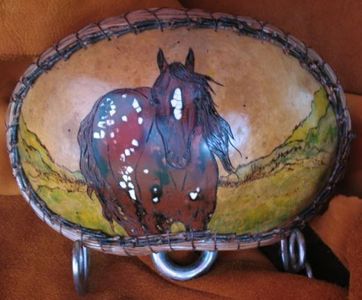 |
- Cover with 2 layers of black, and sand again with 200.
- You are ready to switch color.
- Sand carefully with 300 and 400.
- It is very important to have a light touch here.
- You want to remove all the sanding lines left by the coarser sanding. Otherwise your red varnish will get
into these lines, and when you will sand the red the lines will show.
- If you like the lines, lightly sand with a coarser grit instead
- Mix red pigment with the varnish. The consistency must be thick, like
pancake batter.
- Apply 2-3 coats of red on top of the entire gourd piece
- Carefully sand with 300 then 400 until you reach a pleasing pattern.
(Apply more varnish and sand again until you are happy)
- Finish with a 600 grit or more, and then 2 layers of uncolored varnish.
Spray polyurethane for a smoother look.
Other examples of eggshell inlay
Gourds by Claire Cassan.
